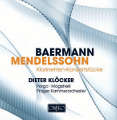ORFEO International – Reviews
Important Releases Briefly Introduced
February 2009
ORFEO 1 CD C 673 091 A
Baermann - Mendelssohn
Heinrich Baermann and his son Carl were two of the great clarinet virtuosos of the 19th century, their artistry celebrated the length and breadth of Europe. To their friendship with Felix Mendelssohn we owe the latter’s two Concert Pieces opp. 113 and 114, works associated with an amusing anecdote retailed by Carl Baermann, who reports that the alternative title of the first piece – “grand duet for sweet yeast dumpling and cream puff, clarinet and basset-horn” – stems from a culinary duel fought between him and Mendelssohn in Berlin at the end of 1832, when the Baermanns were on their way to St Petersburg for a series of concerts. 
C 673 091 ABy preparing yeast dumplings and cream puffs, Carl Baermann apparently persuaded Mendelssohn to respond to a commission that his father had given him some time earlier, encouraging him to slave away at his “piano stove”, while he himself busied himself in the kitchen. It cannot be said that either of these two works simmers at a low heat or that the second of them should be “thrown into the fire”, as Mendelssohn himself insisted. In his new recording of these works on the Orfeo label, Dieter Klöcker ensures that these exuberant pieces come nicely to the boil. In this he is aided and abetted by Luigi Magistrelli on the basset-horn and by the Prague Chamber Orchestra. With Giuseppe Porgo he also rehabilitates two parallel works by Carl Baermann that demonstrate the latter’s abilities as a composer in addition to his skills as a cook. The better known of the two pieces is undoubtedly the Duo concertant op. 33 that father and son are known to have played together in Paris, where they galvanized the musical life of the city. The work is highly effective thanks not least to its dramatic character, with contrasting passages that veer between march and dance rhythms on the one hand and lyrical cantilenas on the other. In his Concertante for two clarinets and orchestra, finally, Carl Baermann produced a piece that is a classic example of the sort of clarinet virtuosity that was even then coming to an end, its Classical introduction gradually giving way to typically Romantic colours and intervals, some of which reveal Slavonic influence. Here, too, Dieter Klöcker, Giuseppe Porgo and the Prague Chamber Orchestra are entirely in their element, deriving evident pleasure from some of the wide-ranging intervals and from musical turns of phrase that are by no means expected.
top |